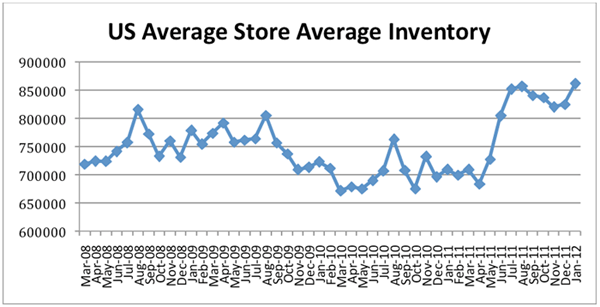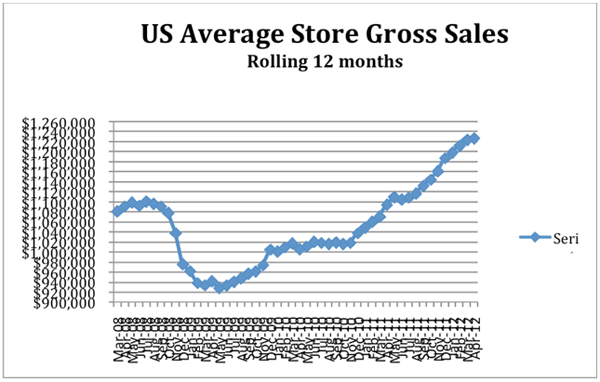
David Brown: Inventory Levels Climb on Improving Sales Figures
BY DAVID BROWN

Published in the July 2012 issue
The results for April again show a continuing trend of increasing sales for most jewelry stores, with our benchmarking data indicating an increase in rolling 12-month total sales of 0.25 percent. This is the lowest monthly change in growth of the last few months, but is still an increasing figure, and would translate to annual growth of just on 3 percent if the trend continued.
Of particular note in recent times has been the increase in inventory on hand at most stores. When the economy was tough, many looked to hold back on what they stocked, but, as the graph below shows, many months of consistent growth have seen a large-scale increase in inventory on hand.
Now, if you really want to depress yourself you could look at this in terms of sales dollars, and how much goes back out to other people before there is anything left for you.

Advertisement
The figures depict the average inventory holding for the typical U.S. jewelry store over the last four years. As the data shows, inventory levels consistently bounced along in the $700,000 to $850,000 range during this time. As the crisis began, inventory levels plummeted as Main Street jewelers found themselves without the cash to restock product as it sold. Higher-end diamonds in particular saw a heavy reduction in product being carried.
Over the last 12 months, however, as retail confidence has returned, we’ve seen an increase in the value of jewelry on hand, with some major reinvestment being undertaken over the April-to-July period, no doubt coinciding with the biggest trade shows of the year.

So how does this compare with sales? Well, as we have shown lately, there has been a clear and consistent increase in sales being achieved by your typical store. In order to match the growth it makes sense to increase inventory levels accordingly.
What is a concern, however, is the type of product that is being restocked. The fact that the large-scale increase in inventory is happening at the same time as shows suggests that stores are not reordering fast-selling items – they are choosing new product to replenish their cabinets back to their former level.
Is this a good thing? Well, certainly every store needs new product and something fresh to show – but what is happening to the proven sellers, the items that generated sales in the first place?
Advertisement
If they have successfully sold once there is a good chance they will sell again – but they often don’t get the opportunity to prove themselves. We may repeat ourselves often on this but the reality is, for any jeweler, less than 20 percent of your products are likely generating 80 percent of your sales. Not getting these products back is depriving you and your business of profits.
The other issue with restocking at shows is that it means waiting until the chance comes along to view new product. The inventory graph above shows that the period from December 2011 until April 2012 saw lower levels of product being held by stores than there had been leading up to Christmas. That may be fine in some cases, as December sales are likely to be higher – however, if the missing items are good sellers, then that would leave the store without fast selling product for 4-5 months. If these good sellers turned over at the rate of two to three times per year, that could be one missed sale for every item not reordered during this time.
Reordering fast sellers regularly is also smoother for cash flow. “Saving up” orders may seem to help with deferring payment, but it just means the payments get bigger when they have to be made. Like exercise, little and often is better for you.
What should you be doing to make reordering easier?
Review your sales for the last month. A good reporting system should show you which items were fast sellers and make it easy to identify what needs to be bought again.
Don’t emotionalize. Rather than justifying why you should get it back in (for example, “I’ve got a car payment next week”) ask yourself why you shouldn’t get it back. All fast sellers (ignoring special orders) should be presumed innocent until proven guilty! They should automatically be returned to inventory unless there is a good reason not to.
Advertisement
Give the reordering job to someone else. That may make you squirm but a staff member is more likely to do it by the numbers and unemotionally than you might if your money is involved. You can still sign off on sending the order, just have someone else find the fast sellers, then you have to justify to them as to why it shouldn’t be restocked.
Measure what percentage of product coming in is fast sellers. Again your reporting system should be able to assist with providing this information but, in most circumstances, 70 percent or more of product coming in should be reorders rather than new unproven pieces. Does the farmer milk a cow only once? No. So why should you replace the herd after every milking session?
About the Author: David Brown is President of the Edge Retail Academy, an organization devoted to the ongoing measurement and growth of jewelry store performance and profitability. For further information about the Academy’s management mentoring and industry benchmarking reports contact Carol Druan at carol@edgeretailacademy.com or Phone toll free (877) 5698657 Edge Retail Academy, 1983 Oliver Springs Street Henderson NV 89052-8502, USA